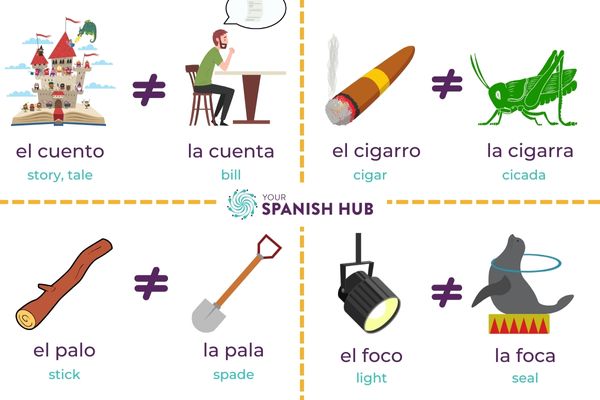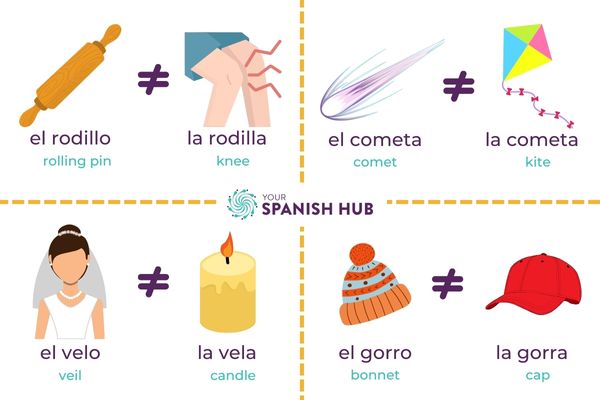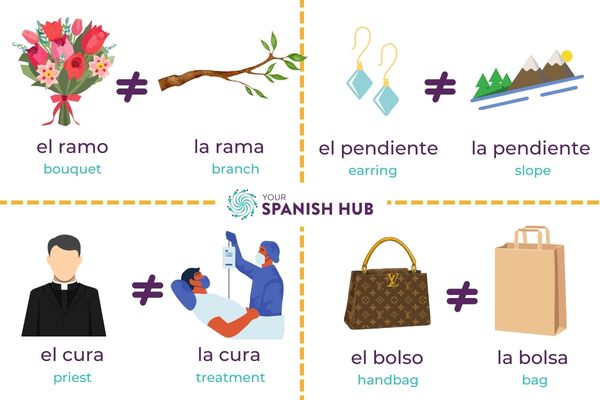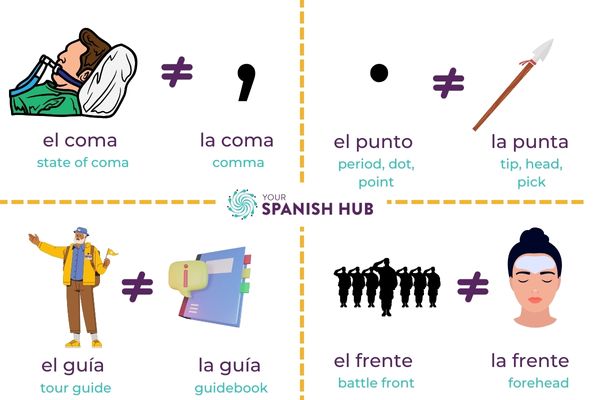In Spanish grammar, one of the aspects that you have to take into account is that all nouns have gender: masculine or feminine.
This is one of the first topics I see with my beginner students because, many times, they find it strange that “nose” is feminine (la nariz) or that “tree” is masculine (el árbol).
One of the first rules of Spanish grammar that you learn in your classes is that there are many words in Spanish that end in “o” and that are masculine, and there are also many words that end in “a” and that are feminine.
This is a Spanish grammar rule that works many times, but not always 😉
However, there is a small group of very interesting words. Personally, I am fascinated to see how changing the gender of one of these words, the meaning completely changes.
In fact, they are two totally different words that have nothing to do with each other.
In this article, we are going to discover sixteen of these words (although there are a few more) and you will see some surprising changes in meaning.

To be sure of the gender of a noun, look at the words around it, because the Spanish grammar rule of the ending of the word in “o” or “a” to know its gender, doesn’t always work.
Here are some examples: nariz (nose), túnel (tunnel), compás (compass), tenedor (fork)… Many times, accompanying the nouns are the definite articles (el, la, los, las) and the indefinite articles (un, una, unos, unas).
Pay attention to these articles and you will immediately know the gender of the noun they accompany: la nariz, el túnel, el compás, el tenedor…
El cuento: narrative or short story, usually fictional.
Susana le lee un cuento a su hija todas las noches antes de dormir.
La cuenta: the receipt that we asked for at the restaurant with the amount for what we ate and drank.
Sandra, pide la cuenta al camarero y nos vamos a la playa.
El cigarro: roll made of tobacco for smoking.
Mi tía siempre fuma un cigarro después de comer.
La cigarra: green insect that makes a strident noise, especially when it is hot.
En España, en verano, es normal oír a las cigarras cantar.
El palo: long and cylindrical piece of wood.
A mi abuelo Rafa le gustaba caminar por el campo con un palo de madera.
La pala: tool with an iron plate that is used to collect and carry materials.
Los albañiles usan la pala para echar materiales a la hormigonera.
El foco: very powerful electric light lamp.
Iluminaron el edificio con focos de colores.
La foca: mammalian animal with aquatic habits that generally lives in cold seas.
El cambio climático es una amenaza para las focas polares.

El rodillo: wooden or plastic cylinder used to stretch dough.
Necesito un rodillo para cocinar pizza casera para comer.
La rodilla: joint where the thigh joins the lower leg.
Andrés se hizo daño en la rodilla ayer jugando al fútbol.
El cometa: celestial body made up of dust, rocks and ice particles that orbits the Sun following different elliptical paths.
El cometa Halley orbita alrededor del sol cada 76 años.
La cometa: fabric or plastic surface, very light, with a frame that keeps it flat with a very long thread that is thrown into the air to make it fly.
Los niños están en el parque jugando con la cometa.
El velo: thin, delicate fabric that covers something.
La abuela de Sara hacía y vendía velos para las novias.
La vela: piece of wax or paraffin, generally cylindrical with a wick that lights and illuminates.
Me gusta decorar la mesa con velas cuando hay cenas especiales.
El gorro: garment of cloth or knit to cover and shelter the head.
Por las mañanas, en invierno, llevo un gorro de lana cuando voy a trabajar.
La gorra: cloth garment with a visor to cover the head and generally protect it from the sun.
En Boston compré mi gorra favorita y en verano la uso muchísimo.

Practising Spanish grammar is usually one of the aspects most requested by Spanish students. But as we are seeing in this article, the part of grammar with the change in gender of nouns is inevitably linked to the part of vocabulary, as we see with the change in meaning of words.
In the end, to be able to communicate in Spanish, you have to work on all aspects of the language, including the cultural one.
El ramo: bunch of flowers and herbs.
María ha tenido a su segundo hijo y le vamos a enviar un ramo de flores al hospital.
La rama: part of the tree that grows from the main trunk.
Las ramas del árbol de mi jardín dan una sombra estupenda en verano.
El pendiente: jewel or accessory that is generally worn in the ears.
Mis pendientes favoritos son dos aros de oro.
La pendiente: inclined terrain.
Cuando fuimos a las montañas de Cuenca, subimos una gran pendiente con el coche.
El cura: priest of the Catholic Church.
El cura de mi pueblo es muy simpático.
La cura: treatment for a disease.
El médico me recetó una cura para la herida que me hice en el brazo.
El bolso: accessory made of leather, fabric, wool, plastic… that is used to carry money, documents or objects for personal use.
Ann le regaló a mi madre un bolso escocés con estampado de cardos.
La bolsa: small bag usually made of plastic or paper that is used to carry or move things.
Mi padre trajo una bolsa llena de cerezas de nuestra pequeña granja en el campo.

El coma: state in which a patient has lost consciousness, sensitivity and the ability to move.
Juan estuvo tres semanas en coma después del grave accidente que sufrió.
La coma: writing spelling sign.
Cuando escribes los elementos de una lista, tienes que separarlos con comas.
El punto: writing spelling sign.
Al final de cada frase, hay que escribir un punto.
La punta: Extreme of something.
El cuchillo cayó al suelo y la punta se rompió.
El guía: person who shows visitors monuments, museums, places…
El guía turístico nos mostró el interior de la Catedral de Toledo.
La guía: book that collects information on a topic.
Mi hermana me regaló una guía de plantas para mi curso de botánica.
El frente: line or territory of battle in which two armies fight each other.
El frente ruso avanzó en algunos territorios de Ucrania.
La frente: upper part of the face.
Se me ha quemado la frente con el sol porque olvidé ponerme crema de protección solar.
Gap-filling activities are a favourite among students who love Spanish grammar and want to practise, practice, practice.
Particularly popular are grammar activities to practise verb tenses and verb modes, specifically the subjunctive.
If you like to practise Spanish grammar on your own, at your own pace and without a teacher, I encourage you to visit the Your Spanish Hub Membership Programme, with video lessons of about 10 minutes and self-correcting activities.
Use the membership search engine to filter courses by categories (grammar, spelling, vocabulary and conversation) and by levels (A1, A2, B1, B2) and start learning and practising for yourself.
Enjoy new courses every 15 days!
